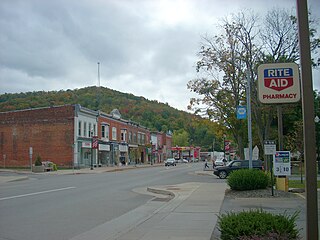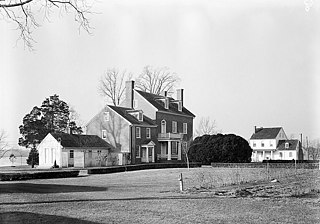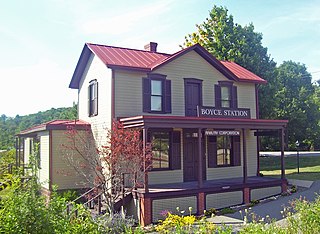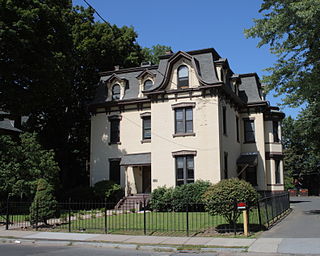
The Allegheny River is a 325-mile (523 km) long headwater stream of the Ohio River in western Pennsylvania and New York, United States. The Allegheny River runs from its headwaters just below the middle of Pennsylvania's northern border northwesterly into New York then in a zigzag southwesterly across the border and through Western Pennsylvania to join the Monongahela River at the Forks of the Ohio on the "Point" of Point State Park in Downtown Pittsburgh, Pennsylvania. The Allegheny River is, by volume, the main headstream of both the Ohio and Mississippi Rivers. Historically, the Allegheny was considered to be the upper Ohio River by both Native Americans and European settlers.

Potter County is a county located in the U.S. state of Pennsylvania. As of the 2010 census, the population was 17,457, making it the fifth-least populous county in Pennsylvania. Its county seat is Coudersport. The county was created in 1804 and later organized in 1836. It is named after James Potter, who was a general from Pennsylvania in the Continental Army during the American Revolution. Due to its remoteness and natural environment, it has been nicknamed “Gods Country.” The county is also known for its white supremacy movements.

Port Allegany is a borough in McKean County, Pennsylvania, United States. The population was 2,157 at the 2010 census.

Coudersport is a borough in and the county seat of Potter County, Pennsylvania, United States, located approximately 110 miles (180 km) east by south of Erie on the Allegheny River. The population was 2,546 at the 2010 census.

Union Station is a historic train station at Grant Street and Liberty Avenue, south of the Allegheny River, in Pittsburgh, Pennsylvania, United States. It was one of several passenger rail stations that served Pittsburgh during the 20th century, and it is the only surviving station in active use.
U.S. Route 6 (US 6) travels east–west near the north edge of the U.S. state of Pennsylvania from the Ohio state line near Pymatuning Reservoir east to the Mid-Delaware Bridge over the Delaware River into Port Jervis, New York. It is the longest highway segment in the Commonwealth. Most of it is a two-lane rural highway, with some freeway bypasses around larger towns. Except east of Dunmore, where it is paralleled by Interstate 84 (I-84), it is the main route in its corridor. What is now I-80—the Keystone Shortway—was once planned along the US 6 corridor as a western extension of I-84. The corridor was originally the Roosevelt Highway from Erie, Pennsylvania to Port Jervis, New York, designated Pennsylvania Route 7 in 1924. The PA 7 designation soon disappeared, but as US 6 was extended and relocated, the Roosevelt Highway followed it. The Pennsylvania section of US 6 was renamed the Grand Army of the Republic Highway in 1946; this name was applied to its full transcontinental length by 1953.

Cherry Springs State Park is an 82-acre (33 ha) Pennsylvania state park in Potter County, Pennsylvania, United States. The park was created from land within the Susquehannock State Forest, and is on Pennsylvania Route 44 in West Branch Township. Cherry Springs, named for a large stand of Black Cherry trees in the park, is atop the dissected Allegheny Plateau at an elevation of 2,300 feet (701 m). It is popular with astronomers and stargazers for having "some of the darkest night skies on the east coast" of the United States, and was chosen by the Pennsylvania Department of Conservation and Natural Resources (DCNR) and its Bureau of Parks as one of "25 Must-See Pennsylvania State Parks".
The Jersey Shore, Pine Creek and Buffalo Railway was a railroad built in the early 1880s to give the New York Central and Hudson River Railroad access to the coal regions around Clearfield, Pennsylvania, United States. It was originally planned as part of a connecting line between the East Coast of the United States and Buffalo, New York.

WFRM is a commercially licensed AM radio station, licensed to Coudersport, Pennsylvania, the seat of Potter County. WFRM has served listeners in Potter, Elk, Mckean & Cameron counties for 60 years at the federally assigned frequency of 600 kHz at a maximum power output of 1,000 watts day, 46 watts night. WFRM and its sister station, WHKS, are owned by L-Com, Inc., a company controlled by David Lent.

Jackson is a historic Amtrak station in Jackson, Michigan, United States. It is served by the Wolverine. The station was added to the National Register of Historic Places in 2002.
The Wellsville, Addison & Galeton Railroad was formed in 1954 to operate a section of Baltimore & Ohio Railroad (B&O) trackage which had been isolated from the rest of the system by a 1942 flood. This trackage was acquired by the B&O as part of the purchase of the Buffalo & Susquehanna Railroad (B&S) in 1932. It is known as the operator of a set of GE centercab diesels supplemented by F7 locomotives in later years.

Potter Hall is a historic home located at Williston, Caroline County, Maryland, United States. It is an early-19th-century, Federal-influenced house facing the Choptank River. The house was constructed in three sections: a tall 2 1⁄2-story Flemish bond brick structure built about 1808 adjoining a lower 2 1⁄2-story, two-bay-wide central section built about 1750, also of Flemish bond brick, then a frame single-story kitchen wing added in 1930. Each of the three sections has a gable roof. Potter Hall was originally settled by Zabdiel Potter, who in the mid-18th century built a wharf and the small brick house. He developed Potter's Landing into a key early port for the shipping of tobacco to Baltimore.

The Potter County Courthouse is the primary government building of Potter County, Pennsylvania, United States. Located in the Coudersport Historic District in the Potter county seat of Coudersport, it was added the National Register of Historic Places on February 24, 1975. The courthouse is a Greek Revival structure with some Victorian elements blended into it.

The Coudersport Historic District is a historic district in Coudersport, the county seat of Potter County, Pennsylvania in the United States. The district encompasses 73 contributing buildings. Coudersport is in a narrow valley on the Allegheny River and was a boom town when the lumber industry cut the white pine and hemlock forests in the county. Much of the borough's Victorian era architecture stems from this time, and when the lumber was exhausted by the early 20th century, the borough declined in population and economically, preserving many of the historic structures. The district is centered on the Courthouse Square and notable buildings include the Park United Methodist Church (1893), Presbyterian Church (1902), Episcopal Church (1883), Old Hickory Tavern, and Coudersport Consistory complex.

The Buffalo and Susquehanna Railroad was a railroad company that formerly operated in western and north central Pennsylvania and western New York. It was created in 1893 by the merger and consolidation of several smaller logging railroads. It operated independently until 1929, when a majority of its capital stock was purchased by the Baltimore and Ohio Railroad. At the same time, the B&O also purchased control of the neighboring Buffalo, Rochester, and Pittsburgh Railway. The Baltimore and Ohio officially took over operations of both roads in 1932.

The Coudersport and Port Allegany Railroad was a shortline railroad that operated in Potter and McKean Counties in Pennsylvania in the United States between 1882 and 1964. The original line ran 17 miles (27 km) along the Allegheny River between the boroughs of Coudersport, the county seat of Potter County, and Port Allegany in McKean County. The line was originally a 3 ft narrow gauge and converted to 4 ft 8 1⁄2 instandard gauge in 1889. It was prosperous during a lumber boom in the region and expanded east to Ulysses. The lumber boom ended in the early 20th century and the line slowly declined until 1964, when it was purchased by the Wellsville, Addison and Galeton Railroad. The line was finally abandoned in 1970. Today the only surviving building from the railroad is the Coudersport and Port Allegany Railroad Station, which was listed on the National Register of Historic Places in 1976 and serves as the town hall for Coudersport today. As of 2009, much of the C&PA railroad grading can still be found. Railroad bridge abutments exist at Lillibridge Creek in Port Allegany and along the Allegheny River at Coleman Mills, east of Roulette, and east and west of Coudersport.

Boyce is a disused train station located at the junction of Boyce Road and the tracks of the Chartiers Branch in Upper St. Clair, Pennsylvania, United States. It was built in 1900, and housed not only the rail operations but a post office and general store for the small community it served.

136–138 Collins Street is an architecturally distinguished Second Empire house in Hartford. Built about 1870, it is a rare and well-preserved example of this style in the city. It was listed on the National Register of Historic Places on April 29, 1982.

Lebanon station, also known as Reading Railroad Station, is a historic train station in Lebanon, Pennsylvania. Designed by the Wilson Brothers & Company in the Shingle Style and built by the Reading Company in 1900, it consists of two sections connected by a large overhanging roof.

The New York & Pennsylvania Railroad (NYP) was a single track, shortline railroad running on a route described as east—west in the company's timetables, but closer to an arc: almost due south along Bennett's Creek from Canisteo through the hamlets of Greenwood, Rexville, and Whitesville, New York, southwest through Genesee, Pennsylvania to Oswayo, Pennsylvania, then northwest through Shinglehouse, Pennsylvania to Ceres, New York. In Canisteo trains made "a close connection" with "electric cars for Hornellsville". Trains connected in Canisteo with the Erie Railroad, with service to Buffalo and New York City; in Genesee with the Buffalo and Susquehanna Railroad, with service to Wellsville, New York, and in Ceres with the Pittsburg [sic], Shawmutt, and Northern Railroad, with service to Olean, New York, and points west. While the railroad did not serve Hornell, occasionally it did run special trains, using the Erie tracks. Its route was primarily in southwestern Steuben County, New York, and northern Potter County, Pennsylvania, with small portions in Allegany County, New York, and McKean County, Pennsylvania. Total track was 56.13 miles (90.33 km) main line and 7.69 miles (12.38 km) of sidings.



















